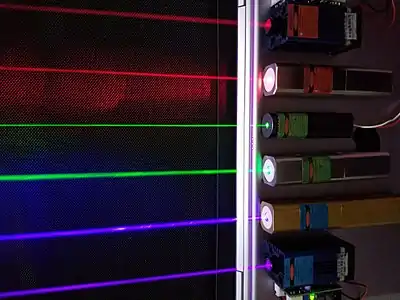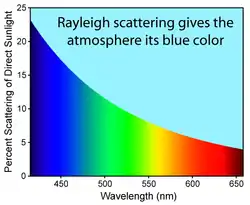瑞利散射
瑞利散射(),由英国物理学家約翰·斯特拉特,第三代瑞利男爵(John Strutt, 3rd Baron Rayleigh)的名字命名。[1]它是半径比光或其他電磁輻射的波长小很多的微小颗粒(例如單個原子或分子)对入射光束的散射。瑞利散射在光通過透明的固體和液體時都會發生,但以氣體最為顯著。



在大氣中,太陽光的瑞利散射會導致瀰漫天空輻射,這也是天空为藍色和太陽偏黃色的原因。
瑞利散射適用於尺寸遠小於光波長的微小顆粒,和光學的“軟”顆粒(即其折射率接近1)。当顆粒尺度相似或大於散射光的波長时,通常是由米氏散射理論、離散偶極子近似和其它計算技術来處理。
瑞利散射光的強度和入射光波长λ的四次方成反比:
其中是入射光的光強分布函數。
因此,波長較短的藍光比波長較長的紅光更易產生瑞利散射。
藍天與夕陽

瑞利散射可以解釋天空為什麼是藍色的。白天,太陽在頭頂,當太陽光經過大氣層時,與空氣分子(其半徑遠小於可見光的波長)發生瑞利散射,因為藍光比紅光波長短,瑞利散射發生得比較激烈,被散射的藍光佈滿了整個天空,從而使天空呈現藍色,但是太陽本身及其周圍呈現白色或黃色,是因為此時看到更多的是直射光而不是散射光,所以日光的顏色(白色)基本未改變——波長較長的紅黃色光與藍綠色光(少量被散射了)的混合。但因為人眼對不同顏色的敏感度不同,以黃綠色敏感度最高,往兩邊呈鐘形分佈,因此人眼對藍色的敏感度遠大於紫色,所以即使散射的可見光波長中紫光能量最高,人眼看起來仍是藍色。
當日落或日出時,太陽幾乎在我們視線的正前方,此時太陽光在大氣中要走相對很長的路程,所看到的直射光中的藍光大量都被散射了,只剩下紅橙色的光,這就是為什麼日落時太陽附近呈現紅色,而雲也因為反射太陽光而呈現紅色,但天空仍然是藍色的,只能說是非常昏暗的藍黑色。如果是在月球上,因為沒有大氣層,天空即使在白天也是黑的。
推導
大氣中的分子在入射光電矢量作用下會極化,從而產生偶極輻射,輻射能流密度的平均值為
瑞利非偏振散射光強度
表示入射光強度,爲入射光與散射光的夾角.
參見
參考
- Lord Rayleigh (John Strutt) refined his theory of scattering in a series of papers that were issued over a period of decades. Here is a partial list of those papers:
- John Strutt (1871) "On the light from the sky, its polarization and colour," Philosophical Magazine, series 4, vol.41, pages 107-120, 274-279.
- John Strutt (1871) "On the scattering of light by small particles," Philosophical Magazine, series 4, vol. 41, pages 447-454.
- John Strutt (1881) "On the electromagnetic theory of light," Philosophical Magazine, series 5, vol. 12, pages 81-101.
- John Strutt (1899) "On the transmission of light through an atmosphere containing small particles in suspension, and on the origin of the blue of the sky," Philosophical Magazine, series 5, vol. 47, pages 375-394.
參考書籍
- C.F. Bohren, D. Huffman, Absorption and scattering of light by small particles, John Wiley, New York 1983. Contains a good description of the asymptotic behavior of Mie theory for small size parameter (Rayleigh approximation).
- Ditchburn, R.W. 2nd. London: Blackie & Sons. 1963: 582–585. ISBN 978-0-12-218101-6. 已忽略未知参数
|url-access=(帮助) - Chakraborti, Sayan. . American Journal of Physics. September 2007, 75 (9): 824–826. Bibcode:2007AmJPh..75..824C. arXiv:physics/0702101. doi:10.1119/1.2752825.
- Ahrens, C. Donald. 5th. St. Paul MN: West Publishing Company. 1994: 88–89. ISBN 978-0-314-02779-5.
- Lilienfeld, Pedro. . Optics and Photonics News. 2004, 15 (6): 32–39. doi:10.1364/OPN.15.6.000032. Gives a brief history of theories of why the sky is blue leading up to Rayleigh's discovery, and a brief description of Rayleigh scattering.
